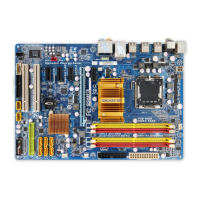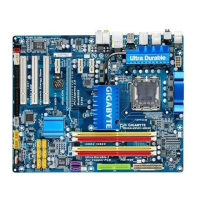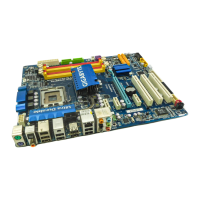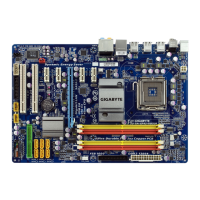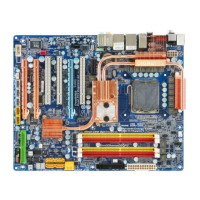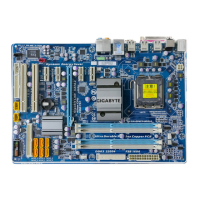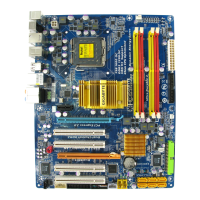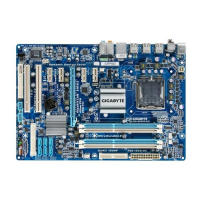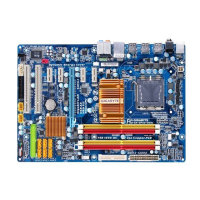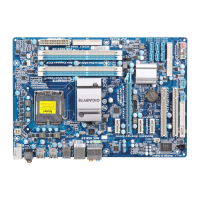Do you have a question about the Gigabyte GA-EP45-DS3 and is the answer not in the manual?
Guidelines for safe and correct installation of motherboard components, including ESD protection.
Detailed list of hardware specifications for the motherboard and its components.
Step-by-step instructions for installing the CPU and its cooling solution.
Guide on how to install DDR2 memory modules correctly and configure dual channel.
Procedure for installing PCI Express and PCI cards into the motherboard slots.
Instructions for installing the SATA bracket to connect external SATA devices.
Overview and description of all external connectors available on the motherboard's back panel.
Identification and function of all internal connectors on the motherboard.
Explains the screens that may appear during the computer's boot process.
Overview of the BIOS Setup program's main menu and navigation keys.
Configuration options for CPU, memory, and voltage settings for performance tuning.
Settings for system date, time, and basic IDE/SATA device configuration.
Options for boot device priority, password settings, and system performance features.
Configuration for onboard devices like SATA, USB, LAN, and audio controllers.
Settings related to ACPI sleep states, power button behavior, and wake-up events.
Configuration for Plug and Play (PnP) and PCI slot resource assignments.
Monitoring system temperatures, voltages, and fan speeds, with warning settings.
Resets BIOS settings to the safest, most stable factory defaults for troubleshooting.
Resets BIOS settings to optimal factory defaults for performance.
Allows setting supervisor or user passwords to protect BIOS and system access.
Saves current BIOS configuration changes and exits the setup utility.
Exits BIOS setup without saving any changes made during the session.
Configuration options for the security chip, if available on the motherboard.
Guide to installing essential chipset drivers for proper system operation.
Information on GIGABYTE utilities and free software included on the driver disk.
Details about application guides, driver disk content, and motherboard manuals.
Information on how to contact GIGABYTE for support and inquiries.
Page displaying basic system information, including BIOS and hardware details.
Link to GIGABYTE's website for downloading the latest BIOS, drivers, and applications.
Utility for quick system data backup and restoration using NTFS, FAT32, FAT16 file systems.
Explains GIGABYTE's Q-Flash and @BIOS tools for updating the system BIOS.
Software for fine-tuning system settings, overclocking, and monitoring hardware in Windows.
Technology for advanced power savings and enhanced power efficiency without performance sacrifice.
Features advanced hardware-based data encryption using Trusted Platform Module technology.
A tool for easy and convenient data sharing between computers on a network.
Utility for backing up and restoring system data using Microsoft Volume Shadow Copy Services.
Enables dual LAN connections to act as a single connection for increased bandwidth and fault tolerance.
Steps to install, configure SATA controller mode, and set up RAID arrays for hard drives.
Guide to setting up 2, 4, 5.1, or 7.1 channel audio configurations and connecting devices.
Frequently asked questions and a troubleshooting procedure to solve common system startup issues.
Guidelines for safe and correct installation of motherboard components, including ESD protection.
Detailed list of hardware specifications for the motherboard and its components.
Step-by-step instructions for installing the CPU and its cooling solution.
Guide on how to install DDR2 memory modules correctly and configure dual channel.
Procedure for installing PCI Express and PCI cards into the motherboard slots.
Instructions for installing the SATA bracket to connect external SATA devices.
Overview and description of all external connectors available on the motherboard's back panel.
Identification and function of all internal connectors on the motherboard.
Explains the screens that may appear during the computer's boot process.
Overview of the BIOS Setup program's main menu and navigation keys.
Configuration options for CPU, memory, and voltage settings for performance tuning.
Settings for system date, time, and basic IDE/SATA device configuration.
Options for boot device priority, password settings, and system performance features.
Configuration for onboard devices like SATA, USB, LAN, and audio controllers.
Settings related to ACPI sleep states, power button behavior, and wake-up events.
Configuration for Plug and Play (PnP) and PCI slot resource assignments.
Monitoring system temperatures, voltages, and fan speeds, with warning settings.
Resets BIOS settings to the safest, most stable factory defaults for troubleshooting.
Resets BIOS settings to optimal factory defaults for performance.
Allows setting supervisor or user passwords to protect BIOS and system access.
Saves current BIOS configuration changes and exits the setup utility.
Exits BIOS setup without saving any changes made during the session.
Configuration options for the security chip, if available on the motherboard.
Guide to installing essential chipset drivers for proper system operation.
Information on GIGABYTE utilities and free software included on the driver disk.
Details about application guides, driver disk content, and motherboard manuals.
Information on how to contact GIGABYTE for support and inquiries.
Page displaying basic system information, including BIOS and hardware details.
Link to GIGABYTE's website for downloading the latest BIOS, drivers, and applications.
Utility for quick system data backup and restoration using NTFS, FAT32, FAT16 file systems.
Explains GIGABYTE's Q-Flash and @BIOS tools for updating the system BIOS.
Software for fine-tuning system settings, overclocking, and monitoring hardware in Windows.
Technology for advanced power savings and enhanced power efficiency without performance sacrifice.
Features advanced hardware-based data encryption using Trusted Platform Module technology.
A tool for easy and convenient data sharing between computers on a network.
Utility for backing up and restoring system data using Microsoft Volume Shadow Copy Services.
Enables dual LAN connections to act as a single connection for increased bandwidth and fault tolerance.
Steps to install, configure SATA controller mode, and set up RAID arrays for hard drives.
Guide to setting up 2, 4, 5.1, or 7.1 channel audio configurations and connecting devices.
Frequently asked questions and a troubleshooting procedure to solve common system startup issues.
| Number of memory slots | 4 |
|---|---|
| Maximum internal memory | 16 GB |
| Processor socket | LGA 775 (Socket T) |
| Processor manufacturer | Intel |
| USB 2.0 connectors | 2 |
| Power fan connector | Yes |
| Number of SATA connectors | 6 |
| USB 2.0 ports quantity | 8 |
| VGA (D-Sub) ports quantity | 0 |
| BIOS type | AWARD |
| BIOS memory size | 64 Mbit |
| Audio chip | Realtek ALC889A |
| Audio output channels | 7.1 channels |
| Motherboard form factor | ATX |
| Compatible operating systems | Windows Vista/XP |
| LAN controller | Realtek RTL8111C |
| Networking features | 10/100/1000 Mbit |

